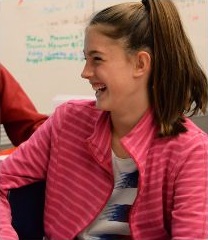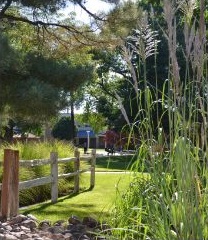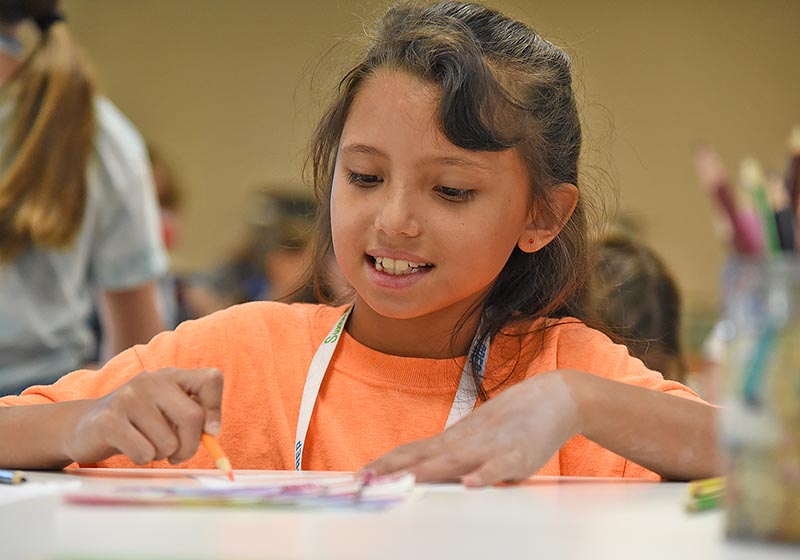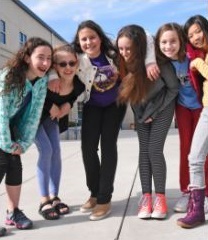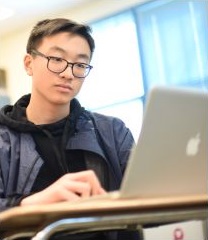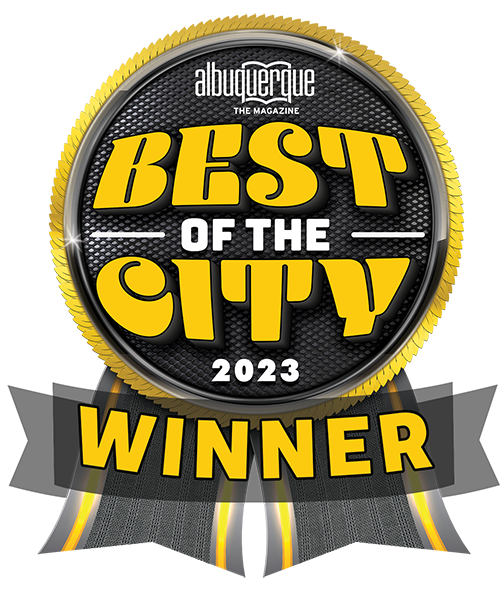ASHLEY - SENIOR
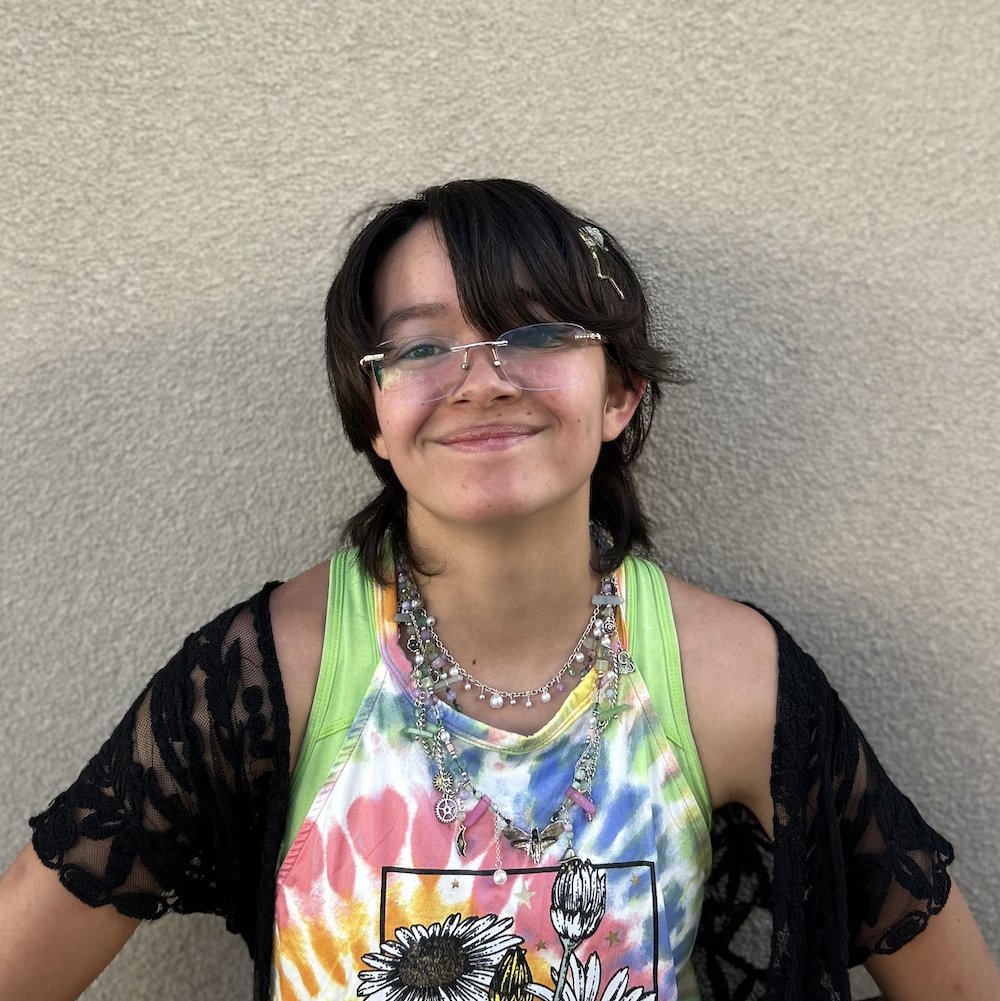 Ashley’s creative approach to her project entails writing a book and creating a channel that will increase understanding about people who are neurodiverse. The term “neurodiverse” refers to a perspective that brain differences are normal, rather than deficits. Neurodiverse people experience and interact with the world in unique ways. That can have challenges, but also can lead to remarkable ideas from a different lens. Ashley said, “I feel as though there’s a lot of misunderstanding among non-neurodiverse people who try to understand neurodiverse minds.” Ashley said her book, which will combine fiction and nonfiction, will focus on issues that neurodiverse people face and the negative consequences it can lead to. “I’ll incorporate a range of traits that neurodiverse people have now that I have done more research,” she said. “I’ll include neurodiverse characters that are autistic, have ADHD, etc.” Ashley said the work is especially important to her because the repression of neurodiverse people to be their true selves can develop into harmful coping mechanisms that can put their lives at risk. Ashley cemented her interest in video production when she edited and animated a video for a charity that helps foster kids in need. She has been drawing since elementary school, and her mind is always full of ideas of what to draw or what stories to create. At Prep, Ashley is a member of the Outdoor Leadership Program, NHS, and is currently in classes that focus on creative writing and story-building. She counts psychology, art, animation, writing, and music among her interests and passions.
Ashley’s creative approach to her project entails writing a book and creating a channel that will increase understanding about people who are neurodiverse. The term “neurodiverse” refers to a perspective that brain differences are normal, rather than deficits. Neurodiverse people experience and interact with the world in unique ways. That can have challenges, but also can lead to remarkable ideas from a different lens. Ashley said, “I feel as though there’s a lot of misunderstanding among non-neurodiverse people who try to understand neurodiverse minds.” Ashley said her book, which will combine fiction and nonfiction, will focus on issues that neurodiverse people face and the negative consequences it can lead to. “I’ll incorporate a range of traits that neurodiverse people have now that I have done more research,” she said. “I’ll include neurodiverse characters that are autistic, have ADHD, etc.” Ashley said the work is especially important to her because the repression of neurodiverse people to be their true selves can develop into harmful coping mechanisms that can put their lives at risk. Ashley cemented her interest in video production when she edited and animated a video for a charity that helps foster kids in need. She has been drawing since elementary school, and her mind is always full of ideas of what to draw or what stories to create. At Prep, Ashley is a member of the Outdoor Leadership Program, NHS, and is currently in classes that focus on creative writing and story-building. She counts psychology, art, animation, writing, and music among her interests and passions.
2023-2024
In June, I volunteered in the Best Buddies Friendship Walk and finished reading the book that Dr. Hayes had recommended to me. Before the Best Buddies Walk was held, my sister and I set up chairs, tables, balloons, and activities for the event and accommodated everyone who was there. There was a speech and warm-ups before the walk was held, and activities were set up there. Some of the activities included Connect-4 and Corn Hole. There were also sponsors for the event, and different groups and schools were at the tents that we set up. I think that the speech was something really empowering because it showed the amount of courage that these people had. They went in order of the letter they were holding for the word ‘Inclusion’, and the leader shouted, “Give me an I, give me an N…” etc. Most of the people who spoke during the speech were young; a couple of them looked like they were in middle school, and one of their voices stuck out to me, “I have the opportunity to be myself.” Their speech is really important to me, and I think it’s amazing about their bravery to make a speech for themselves, especially because I knew that a couple of them were anxious. Martha Mondragon is the Lead Program Manager, and she was really helpful in telling me about the Best Buddies program. I kept in contact with her through June and July and hope to get in contact with her soon.
I scheduled a meeting with Dr. Hayes concerning her book she recommended and I will also tell her about my experience with Best Buddies. I learned a lot of interesting things in the book; for example, the amygdala is a brain region that is involved in emotion processing and fear. Its growth trajectory is altered in many neurodiverse people, which is also linked to the dysregulation of the amygdala implicated in anxiety. Being neurodiverse also affects sleep habits because some have sensitivities to sound and may need earplugs, or noiseless heavy blankets. Images of what happened during the day or social scenarios can also replay in their head, which makes it hard to sleep. For example, a neurodiverse individual may have been exposed to bright lighting during the day, and the image of the bright lighting replays in their head. I learned that exercise is something important for neurodiverse people because exercise can help to decrease the negative effects of sensory issues such as migraines and make them more bearable.
Throughout the month of September, I have been looking into different organizations to see what would be the best way to connect with a variety of different neurodiverse people and finding more resources, deciding what would be the best course of action for me to take next. I decided to attend a conference with one of the Best Buddies’ lead directors, Martha Mondragon, and with Dr. Hayes on September 15 before attending their Leadership Training Day on September 16. When I was in the meeting with Ms. Mondragon and Dr. Hayes, we mostly discussed how I can be more connected with neurodiverse people and have more voices to share their experiences so I can incorporate them into my book. I feel as though that since the Best Buddies program is very broad, it’s more difficult to find the specific type of people that I’m focusing on for my project. When I went to the conference, the environment was very welcoming, and I’m glad I went. Ms. Mondragon gave me some resources, but it was mainly about leadership to have people with disabilities in general–which is a broad spectrum–to connect with people with non-disabilities. I feel like being a full-time ambassador for Best Buddies would hinder my time and isn’t too specific to my Odyssey project, which is why I’m planning to find other organizations that would be more specific to it.
After I went to the conference, I scheduled a meeting with Dr. Hayes a week later, updating her about how it went and how I want to manage my time, as well as deciding on how Best Buddies can benefit me for my project. I’ve decided to try looking for other organizations as well, but Best Buddies said that if I have anything cost-related that benefits their cause, then they would help pitch in, as well as anything else that they may be able to help with. I’m also still talking to Ms. Mondragon to see more about connecting me with other neurodiverse people, and I’m currently asking her if she happens to know other organizations that are specific and can help me with my project. In the meantime, I’m thinking of creating a video with the help of my sister’s roommate to ask around about experiences on YouTube, and possibly other media if I have time, because I think that online responses are the best way to get feedback and voices from others quickly, if my organization search doesn’t work out. This video is also educational, so I hope it also reaches people who are non-neurodiverse and I can possibly get some of their questions on the neurodiverse community.
I’m excited to delve more into my project and to be more involved in the community!
During October, I met up with Dr. Hayes and Dr. Katherine Lee to come up with a teaching plan for 8th grade on December 1st and create a presentation to have reviewed on November 1st. Dr. Katherine Lee teaches the health class for middle school, and I found it an opportunity to share what I have learned over the past year of starting this project. I learned about this through an earlier talk with Dr. Hayes when we talked about how I feel like I was going to do my own thing from what Best Buddies was about because it included a lot of leadership and goals, which would overwhelm me due to time. So, Dr. Hayes recommended that I talk with Dr. Katherine Lee, and she was really nice about what I wanted to say and talk about. Ever since that meeting, I have been brainstorming ways to teach the class about neurodiversity. I decided to make some of the main ideas about sensory struggles, how to make them more bearable, and generally convey understanding and the importance of it.
I think that the month of November will be my busiest and informational month, as I am also getting in contact with an organization called Treehouse. This organization has staff who not only work with neurodiverse individuals but are also neurodiverse themselves. The person that I plan on interviewing is Kelsie Bacon, a neurodiverse therapist who has been there for a while. I would not have found out about this organization without the help of Ms. Jaramillo, and I thank her very kindly for it. The email process of it was a little slow since I emailed the main organization, in which they recommended that Kelsie Bacon would be a great person to interview. It took about two weeks, but I have secured an interview with her and appreciated her time. I am hoping to get insight about her job and how she has helped others with their struggles, and also what she loves about it. I have also given some thought about my end product, and I decided to finish with an animated film instead of a book. This is because I feel unsatisfied with the book, and I feel like I need more time, which I am planning to finish in college. With an animated film, I would be more satisfied with its outcome, and animation is also a passion of mine. It also gives me more room for possible volunteer work and other things I’m involved in, like what was mentioned above. I am very hopeful for what I will learn and new opportunities for me. Thank you for tuning in!
During the month of November, I met with Dr. Katherine Lee to review the PowerPoint I made to teach a class about neurodiversity and reducing sensory issues. One of the meetings was during the 1st and another during the 17th. I also was able to schedule an interview with Kelsie Bacon, a neurodiverse therapist at the organization The Treehouse. Kelsie Bacon was very busy with her schedule since she had training that she had to take throughout the month, but I was able to schedule her for the 30th of November. The meeting I had with Dr. Katherine Lee went very well and she is looking forward to my teaching. She said that the information provided was very helpful. She gave me ideas of possibly asking more questions to the audience and ways that there could be more participation. I am meeting with Dr. Katherine Lee again on December 5th to do a presentation practice run and the class on December 7th. It was originally on December 1st, but her schedule changed, which in my opinion is a blessing because it gives me more time.
My presentation mainly focuses on sensory issues and helps students understand what they are, why people have them, and how to prevent them. It has a video that stimulates someone who may have worse sensory experiences so that students can be put in that perspective, and I ask questions such as “What did you notice?” I also have a breathing exercise as many students who have them are anxious, and it focuses a lot on mindfulness. It talks a little about the different types of misconceptions and stereotypes that neurodiverse people have and explains them better. At the end of the presentation, I am creating a worksheet that has students analyze their own sensory experiences, such as what senses that they like (sensory-seeking) and senses they don’t like (sensory-avoidance). I also give the option of having them explain why they like or dislike the sense. I am also having them write down what they took away from the presentation, for example, what they found interesting, what they learned, etc. I am very interested to see people’s reactions, especially questions that they may have, and I am looking forward to the answers that the students will give.
My Odyssey experience so far has been quite rewarding, and I am content with what I have managed to accomplish. Throughout last year and this semester, I have learned a lot about myself and neurodiversity. Looking back on my response papers and blogs from last year, I came across some comments from Ms. Goessl, and it made me miss her. But, nonetheless, I think that having two different Odyssey teachers made the experience more interesting. Ms. Goessl’s approach was more laid-back, while Ms. Jaramillo is more studious. I think it was nice to get a feel of both styles for constructing my Odyssey journey and for the future. I think that I definitely feel more confident about what my project will be compared to when I first started, because before intensive research, I didn’t really understand much about the technical terms or the closer perspective of neurodiversity. I mainly understood neurodiversity from a more general perspective, for example being misunderstood, but not most of the specifics as to why and some other underlying stigmas.
Over the year and this semester, I now understand more struggles than I originally thought about, such as Alexithymia, executive dysfunction, sensory processing, dysfunctional emotional regulation, and more. Before, I understood a few of the terms, but I didn’t know how to navigate it in a way where it can be supported or understood. From the multiple sources that I have read, every piece of neurodiversity is normal, and that is mainly the misunderstood part of it. Also, due to underlying neurodevelopmental conditions, people who may have conditions such as Alexithymia can come across as rude or lacking empathy. One of the main reasons this is the case is because many neurodiverse people do not have guidance of how to regulate and recognize their emotions, and neurodiversity-affirming techniques most likely were never learned. The lack of neurodiverse-affirming spaces sparked my interest in teaching a health class for Dr. Katherine Lee later on in Year 2. Some other issues that I discovered was why women are misdiagnosed often for specifically the autism spectrum condition. This is due to autism originally being studied only in boys which has led to a diagnostic bias in the health system. In year 1, Dr. Hayes lended me a book that went more into the specifics of the difference between men and women on the spectrum. One of the main reasons that women get misdiagnosed is because they tend to socially mask better, as in not showing repetitive behaviors that therapists and clinicians look for when diagnosing an individual with autism. Repetitive behaviors could be vestibular such as rocking back and forth, having rituals of doing the same things, having routines, etc. Autistic women are also generally more emotional than autistic men, which is also a common misconception because many autistics have high-empathy.
While researching, I also wanted to be more included and participate in a specific neurodiverse group as well. This led me to find organizations that I could possibly volunteer in. The first organization that I was involved in is called Best Buddies. The organization helps out on numerous disabilities and there are also many different chapters within it based on age groups and needs. Dr. Katherine Lee was in one of these chapters when she was in school. I first participated in the Best Buddies Friendship Walk, which was really fun to do. There were many people there and the speeches were memorable and inspiring. Then, I went to their Ambassador Leadership Training Day which had a very welcoming group. Ambassadors would pair up people who did not have disabilities with disabilities and develop friendships. I feel as though that the leadership role and not being directly involved with the specific disabilities I was studying would take me off track for my main project, so I decided to research other organizations that I could be involved with. I discovered the TreeHouse organization through Ms. Jaramillo, and Kelsie Bacon, one of the neurodiverse therapists there, was the most helpful to interview for my project. Ms. Bacon is neurodiverse herself and also helps to support neurodiverse individuals. With her experience, she says that she is very fortunate to have the opportunity to work at the TreeHouse because it helps her to understand herself better and be more affirming. That is also another issue that I feel is prominent in the neurodiverse community which is the lack of understanding creating the lack of affirmation causing many neurodiverse people to feel less valid as an individual. Kelsie Bacon also referred me to a neurodiverse coalition meeting which discussed a lot of topics and some interesting projects that the group was doing. Since the meeting is quarterly, it doesn’t occur as often, but I am looking forward to participating in it again.
Since I was doing more research and have branched out more than I have expected for my project, I decided to change my product into an animated film. I am still writing, but it will most likely be finished during college because of the amount of research I’m doing and I want to spend more time on it. Most of this semester was research-based, so I’ll be spending the last semester mainly focusing on the animation and what issues I should include in it. I think the process will be very enticing and fun, as well as vigorous and rewarding. The coalition meeting mentioned a festival for neurodiversity that they are organizing, so there is a possibility for my film to debut there. Again, I’m very happy with the progress I have made throughout my Odyssey journey, and I’m looking forward to the new avenues that await!
During January, I read Hell Followed With Us by Andrew Joseph White, The Infinite Noise by Lauren Shippen, rescheduled a meeting with Dr. Hayes, and worked on final ideas for my final product as well as character designs. Last year, I mainly did research from non-fiction books, and this year I wanted to find how autistic characters are portrayed in fiction. I have researched a variety of fiction books and some of them include Unseelie by Ivelisse Housman, Strong Female Character by Fern Brady, etc. There is one memoir from an autistic advocate named Chloe Hayden that I have found out recently who I would also like to read from.
In Hell Followed With Us, the autistic representation is portrayed in a healthy manner and the character has a lot of support. The character’s name is Nick, and one of the scenes I really liked was on how patient his best friend Erin was when he was pressured and needed time to calm down to speak. I also liked how with Benji and Nick’s relationship, Benji respects Nick’s indecisiveness of knowing if he likes or doesn’t like someone, as well as not liking the typical physical affection that comes with relationships. There are also healthy coping mechanisms that Nick has, and it turns into a significant symbol of the story which I also found really interesting. I am currently reading The Infinite Noise as of now, it doesn’t explicitly say that Caleb Michaels is autistic, but he is mentioned as ‘atypical’ and what he describes that he feels is similar to autism. Due to his hyperempathy, Caleb gets into a fight and I also really liked the autistic representation in Young Royals, portrayed by Sara Eriksson. At first I was skeptical, because at first it seemed that the show was implying autism as a ‘superpower,’ but then it showed the struggles that can come with it, such as wanting to fit in by self-sacrificing, losing your identity due to other people, and of course, being over-empathetic. Through this, I have deduced my end product to represent self-sacrifice as its main topic and I’m excited for it to come to life.
During February I have been working on a website and finished reading The Infinite Noise by Lauren Staples, as well as listened to videos from neurodiverse voices such as Layle Paige, Chloe Hayden, and others. The Infinite Noise emphasizes the importance of communication and openness within the relationship and I really liked how in the end they realized they were relying on someone to be the “normal” person in the relationship. Throughout the book, the characters kept what they felt to themselves, ultimately leading to further problems in the future such as anxiety and conflict. They accepted that they both are imperfect and cut through the societal pressures that try to disrupt their lives. I have added some more to my website and I am currently planning to do a mix of art poetry and art, as well as detailing what it means if I feel it as necessary. Other than that, I believe that I am on track to what my final product will be, thank you for reading! :)
As a tribute to The Infinite Noise, here are some song recommendations of autistic musicians, other than Marina, who has chronic fatigue syndrome:
Marina and the Diamonds–Happy Loner, I Am Not A Robot
The Owl City–Fireflies
Courtney Love/Hole–Malibu
Gary Numan–Are ‘Friends’ Electric?
Eminem–The Real Slim Shad
2022-2023
For the past couple of weeks I have mostly been reading a book called Spilling Ink by Anne Mazer and Ellen Potter, which I finished, as well as outlining my story and doing a bit of writing practice. I also gave a speech discussing my Odyssey project.
I have a compilation of four short stories called “Silent Girl,” “Fragmented Dissonance,” and “The Paranormal.” I haven’t thought of a name for the fourth one, but since it’s writing practice I don’t think I will. Through this, I feel as though I’ve recognized more of my writing style. It feels very flow-like and full of imagery, which I aspire it to be, but perhaps it will be a little less poetic so readers have a more clear understanding of the book. I think “Fragmented Dissonance” would be the most similar to the type of writing I’d like to do for the book I plan to start writing in November. The term “dissonance'' is coined from psychology, meaning that a person’s beliefs and behaviors do not align. I chose the title because I feel people who are neurodivergent tend to have their behaviors not aligning with their true nature because a lot of times they have to conceal their behaviors to appear normal. I just added “fragmented” to give the title a bit more flair.
The story is about a girl who belonged to the stars yet now resides on Earth, and finds company in ghosts and ghouls rather than humans. I think one of my favorite lines of it is, “This compelled her perception of her outer intentions to conflict with her inner identity, and her deluded sense of self gradually descended into solitude.” The term “dissonance” mainly ties into what this line is about.
The Odyssey speech I gave made me feel more motivated about my project, and I feel excited to get more responses once my project is completed. I feel as though I learned a lot from the book I read, and it gave me a better understanding of what I should write about--for example, making character sheets and answering questions about the character to have a more clear understanding, as well as making the background more loud/sensual/descriptive. One of the most important things I’ve learned from the book is that reading is one of the keys to writing and that if experiencing writer's block or a lack of motivation, always remember the end goal and why your passion for writing sparked.
For the past few weeks, I have mostly been writing my book, trying to cultivate ideas I want to incorporate. The main premise, I have decided, is to have the main character delve into her dreams so I can add a poetic touch to the real world my character experiences. I want it to be a space for her to cool down and to analyze more in-depth about how to tackle her problems and why they exist in the first place.
I’m hoping the North Fourth Art Center that Best Buddies recommended will help me fully develop my character’s journey. I learned that keeping a journal comes in really handy when writing a book. When experiencing writer’s block, I can just turn to my journal and use what I had written earlier. I think I am going to try different places to journal, like a park, a cafe, etc., to see how different environments would affect my writing.
I found that I do most of my writing when I am out-and-about because that’s where I feel most inspired. On a recent family trip to Hawaii, I felt inspired by the various settings and about the way people lived there.
I am also hoping to develop a more organized outline that I can incorporate my chapters into, as well as to get feedback from authors who have self-published.
I have experienced a few challenges over the past few weeks, mainly with getting in contact with people. The organization I was trying to work with never called back, so I’m hoping the Art Center is much more available for calling and such. As far as that is concerned, I’m hoping that my next blog will have a ton more information once I get interviews going and in contact with people.
Throughout these weeks I have been planning and gaining more defined ideas about what I want to incorporate in my book. I interviewed Manuel Montoya, a professor of International Management at the University of New Mexico who self-published a book titled Outside the Margins. The book is about the global refugee crisis, specifically Syria, which helped me to recognize the different creative ways I can incorporate structure into my book.
His book is sectioned into three general parts, the first discussing the problem, the second seeing what professionals are saying on the subject, and the third on the resources and actions someone can take to help with the issue.
In the interview, he mentioned that I could integrate principles in my book about neurodiversity that people may not know about and that the media may not cover. He recommended finding an organization that has the same interests as I do--for example, finding ways to reach out and provide information to other people about my topic. He also mentioned the money aspect of publishing, and that I’d need to find someone to sponsor me or an organization that does publishing. He said his book was published under Starline Press, which publishes educational books. He also suggested looking at United Way, a non-profit organization that partners with other organizations and may be willing to sponsor my book. Furthermore, he recommended occupational therapists as well as consultants he knows that I contact for ideas.
Through this new insight, I have reached out to a therapeutic recreation program that provides fully inclusive programs for youth and adults with and without disabilities. They said they’re building their volunteer program with Family and Community Services and that I can build a service opportunity with their office at the Loma Linda Community Center. They also told me about four other organizations that are on their site that may help with my project.
I am also planning to interview some neurodivergent specialists in New Mexico to see if they have any recommendations to organizations as well as any insights that will be helpful in my work. My future objectives will focus on contacting organizations about interviews and organizing my calendar more thoroughly for the month of February. I’m looking forward to delving deeper into my project.
Below is some artwork that I made--just starter ideas on what I’m thinking for the book. The top left is a test cover and the other three (reads from left to right) are a short comic I made on neurodivergence and it exemplifies how neurodiverse people aren’t as different as neurotypicals are, they just experience life differently.
In February, I conducted an interview with Dr. Amber Hayes, a psychologist at Sandia Prep. I have also read a book titled M is for Autism by the students of Limpsfield Grange School, which focuses on the struggles people on the spectrum face as well as a few coping mechanisms they can utilize.
My interview with Dr. Hayes taught me more about the nature of interviews and the valuable information that I can gain through them. Even though there was a bit of traffic during the morning, Dr. Hayes was kind enough to hold the interview for me. She discussed interesting topics regarding people on the spectrum and her work in her field. She has a background in clinical and school psychology. She knew she wanted to be in the psychology field because of her curiosity about human behavior and her interest in in helping others achieve mental wellness.
Something that fascinated me was her work in neurodiverse programs at UNM. She worked in the diagnostic area regarding people on the spectrum. She believes that meaningful diagnostic work and understanding the condition within the individual are important factors in deciding whether it would be further important for them. She feels that a helpful diagnosis is like a map for an individual. I think it is also very important to consider the individual when understanding a diagnosis because the person is the one who needs the support of understanding who they are. For example, Dr. Hayes discussed the wide range of people on the spectrum, something that should be more well-known, and how it can range in age, and in the different capabilities one is able to do. To emphasize further, a young child who has trouble carrying out their basic needs can be on the same spectrum as someone who doesn’t have trouble with basic needs, but has trouble with social emotional understanding.
She also recognized the difference between women who are on the spectrum and men who are on the spectrum, a misconception that I’d like to delve further into: a main factor that I feel has to do with masking. Masking is where people are able to notice patterns of others around them and copy those patterns, but it will most likely be draining to do so. I was certainly surprised when the criteria between women and men on the spectrum hasn’t been updated and that the criteria is mainly tailored to men.
The book M is for Autism made me consider the struggles people who are on the spectrum go through. M is the main character who has difficulty in her relationship with her parents and her relationships with people at school. Her mother doesn’t understand why she doesn’t like to be hugged or doesn’t say much everytime she comes home from school. She usually does not say why she goes to her room without a word, which causes her mother to worry.
I feel as though that hindered communication and lack of understanding of the spectrum can dig a deep gap in relationships. Once her mother recognizes M’s condition, she understands M’s boundaries and listens to her more, no longer drawing conclusions. That is another thing: Listening to others who are neurodiverse rather than making conclusions about them is very important and is the main key to making them feel included and welcomed. A factor that I didn’t consider before is that M’s autism also tied into her anxiety. Since people on the spectrum experience more intense emotions and stimuli throughout their environment, it can be anxiety inducing to go through. I really liked how the book mentioned that “it is important for someone living with autism to realize they may need to find new strategies and coping mechanisms throughout life’s changes.” Throughout life, there will always be new changes that will have to be faced, but there will always be ways to help make it easier for the specific person.
As of now, I am continuing to write and have even drawn a few backgrounds on how I’d like the layout to be. I have also illustrated a few characters, but I’ll probably change their drawing style in the future. I am also looking into volunteering opportunities so I can work with people who are neurodiverse in the future.
The entrance of the school where my book’s characters go.
This month has been one of the most reflective of all, and I feel as though I have gotten to know more about myself and the story I want to unfold. I have done another interview with Dr. Hayes since I felt the first one was left off abruptly due to time constraints. She has helped me a lot on my journey, and I’d like to thank her for the resources she has shared with me and the information I have learned from her.
Dr. Hayes has helped me in choosing a self-selected book for English and has given me interesting recommendations on people with neurodiversity, including an autobiography titled Thinking in Pictures by Temple Grandin. I hope to read all of the books she’s recommended to me, but right now I decided to choose Counting by 7s by Holly Sloan. Its story follows a girl named Willow Chance who navigates the world in a different way. I find it really interesting how she is able to connect life lessons to her highly passionate interests; for example, one of her main interests is gardening and plants in general. She connects the analogy of life and death to a rose, explaining the process of a rose’s life. She explains how when a rose fades and wilts, it becomes the soil, the wind, and the rain. The cycle continues again and again. I find that to be a beautiful part of nature that I haven’t given much thought to.
Willow Chance also has to grow through the hardships of grief as both of her foster parents die in an accident. I find it interesting how she gets through it, and how her interests became less passionate. I’m still reading it, and I have a feeling that her friend Mai Nguyen will help her through it, since Mai is interested in Willow’s passion. I think that will help in letting that spark continue again. The book also mentions the trait of anxiety for Willow and it seems to be a commonality for people who are autistic.
Not only did Dr. Hayes recommend books with neurodiverse main characters, but also a non-fiction book about girls on the spectrum called Aspergirls by Rudy Simone. I think it is very interesting and I would encourage anyone who is not on the spectrum to read it as well because it looks at the different areas people on the spectrum face and it gives advice not just to people on the spectrum, but to parents and non-neurodiverse people as well. It looks at learning techniques that work, sensory challenges, societal challenges, and, most importantly, acceptance.
It also talks about some differences between girls and boys on the spectrum, some of those differences being the variety of interests. The similarity they share is the intensity of those interests, like Willow Chance’s intense interests that she applies to the real world such as her interest in medical conditions. I like how the book explains how sensory issues are heightened, sort of like animalistic senses--for example, how dogs have heightened smell. I think it sums up pretty well why sensory issues are so overwhelming to people on the spectrum and why we avoid them not because it is a phobia, but because it is something that we cannot control.
Something that really opened my eyes involved how information can be controlled, how much we can research about information and our knowledge on a subject. That would explain why people on the spectrum have such intense interests because it is something that can be controlled: it acts as a safe space. When I am done with my reading, I hope to have another insightful discussion with Dr. Hayes about what I’ve learned from this book and what I can take away from it.
I have decided to change the plot of my book and I have a good feeling that I am going to stick with it, as well as have more time to write it during this summer. It is called The Unicorn in the Vanity and though it might change, I’d say it’s a nice title to start with. I have jotted down ideas and have put them in separate categories. I have gotten an idea of what types of categories I should be thinking of based on my annotations of Counting by 7s and other books I have read. Those categories being self vs. self, self vs. past, self vs. others, the types of connections I want to develop with my characters, hidden details I wanted to include to make the story more interesting, themes and lessons, autistic traits, and ADHD traits.
I have also decided to include an observation category so that I’m constantly writing and thinking about ways to describe certain situations. I decided to start the story off with the main character being disconnected from her true nature, looking at how she feels like she doesn’t belong in nature. She is constantly trying to find herself by pulling away from herself, something that is usually caused by societal pressure to change yourself for others. As the story progresses, I want her to slowly accept her true nature. I want to make sure it is understood by people with neurotypical perspectives as well.
I feel I have come a long way and have learned a lot during this journey, and I am proud of how far I have come. I am looking forward to the discussion with Dr. Hayes and on the stories that are in the works.


